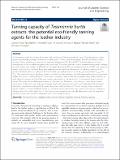| dc.description.abstract | In the present study, the tannins from stem and root barks of Tessmannia burttii Harms (Caesalpiniaceae), a plant
species abundantly growing in Tanzania and other parts of Africa, were investigated for their suitability in hides
tanning. Tannin powder was extracted at selected temperatures (30, 50 and 80 °C) and the influence of each
temperature on the crosslinking capacity was evaluated. The interaction mechanism between hide powder collagen
and the tannins was studied by Differential Scanning Calorimetry (DSC), trinitrobenzensulfonic (TNBS) acid assay and
amino acid hydrolysis methods. Extraction temperatures showed low influence on crosslinking capacity of the
tannins. However, extract obtained at 50 °C exhibited best performance in terms of gap size between T onset and
T peak. The stem bark extract yield was higher than that from the root bark, but both were within the recommended
ranges. The tannin content (61%) of T. burttii stem bark extract was above recommended value (10%), whereas its
total phenolic content and total flavonoic content were found to be above that of commercial Acacia mearnsii
tannin. The study of cross-linking parameters as a function of pH showed cross-linking to occur via a covalent
mechanism at the basic amino groups. However, the bonds were not resistant to acid hydrolysis. The observed
interaction mechanism indicated that tannins from stem and root barks of T. burttii belong to the condensed
tannin, similar to A. mearnsii (black wattle), a commercial tannin source that was used in this study as a reference.
Findings from this study depict that T. burttii extracts are auspicious eco-friendly alternative source of vegetable
tannins to overcome the use of chromium salts in the leather industry. | en_US |

